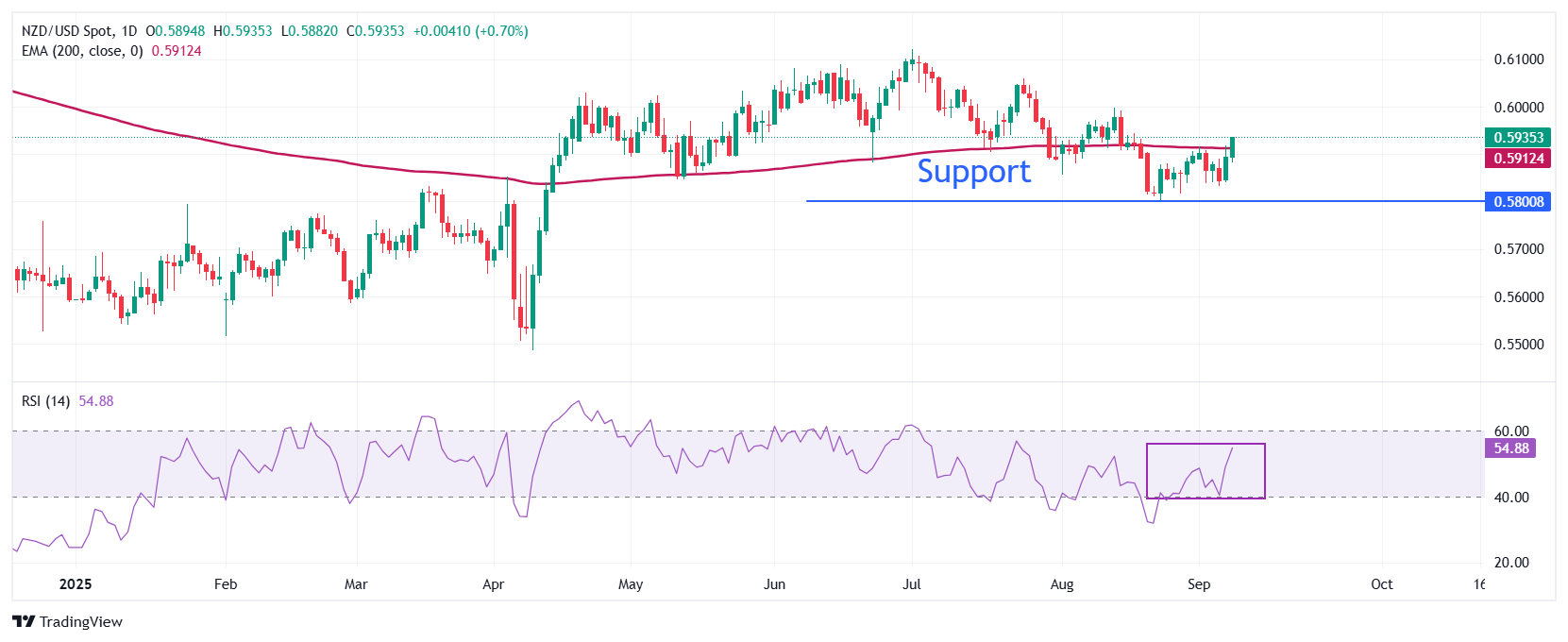NZD/USD Price Forecast: Soars to near 0.5930 amid risk-on market sentiment
- NZD/USD surges to near 0.5930 as the market sentiment turns favorable for riskier assets.
- Soft US NFP data for August has prompted Fed dovish speculation.
- NZD/USD breaks above the 200-day EMA, which trades around 0.5912.
The NZD/USD pair trades 0.66% higher to near 0.5930 during the European trading session on Monday. The Kiwi pair strengthens as the New Zealand Dollar (NZD) outperforms its peers amid cheerful market sentiment.
New Zealand Dollar Price Today
The table below shows the percentage change of New Zealand Dollar (NZD) against listed major currencies today. New Zealand Dollar was the strongest against the US Dollar.
| USD | EUR | GBP | JPY | CAD | AUD | NZD | CHF | |
|---|---|---|---|---|---|---|---|---|
| USD | -0.15% | -0.20% | -0.35% | -0.23% | -0.61% | -0.72% | -0.38% | |
| EUR | 0.15% | -0.06% | -0.12% | -0.09% | -0.45% | -0.51% | -0.23% | |
| GBP | 0.20% | 0.06% | -0.16% | -0.00% | -0.38% | -0.47% | -0.17% | |
| JPY | 0.35% | 0.12% | 0.16% | 0.05% | -0.28% | -0.52% | -0.00% | |
| CAD | 0.23% | 0.09% | 0.00% | -0.05% | -0.29% | -0.44% | -0.15% | |
| AUD | 0.61% | 0.45% | 0.38% | 0.28% | 0.29% | -0.08% | 0.22% | |
| NZD | 0.72% | 0.51% | 0.47% | 0.52% | 0.44% | 0.08% | 0.30% | |
| CHF | 0.38% | 0.23% | 0.17% | 0.00% | 0.15% | -0.22% | -0.30% |
The heat map shows percentage changes of major currencies against each other. The base currency is picked from the left column, while the quote currency is picked from the top row. For example, if you pick the New Zealand Dollar from the left column and move along the horizontal line to the US Dollar, the percentage change displayed in the box will represent NZD (base)/USD (quote).
The demand for riskier assets has increased as the Federal Reserve (Fed) seems certain to cut interest rates in the monetary policy announcement next week.
According to the CME FedWatch tool, traders see a 10% chance that the Fed will cut interest rates by 50 basis points (bps) to 3.75%-4.00%, while the rest point a 25-bps interest rate reduction.
Fed dovish speculation has intensified due to cooling United States (US) labor market conditions.
Upbeat market sentiment has dampened the safe-haven appeal of the US Dollar (USD). During the press time, the US Dollar Index (DXY), which tracks the Greenback’s value against six major currencies, trades lower to near 97.60.
NZD/USD extends its upside above the 200-day Exponential Moving Average (EMA), which trades around 0.5912.
The 14-day Relative Strength Index (RSI) approaches 60.00. A fresh bullish momentum would emerge if the RSI breaks above that level.
Going forward, the Kiwi pair would rise towards the June 19 high of 0.6040 and the September 11 low of 0.6100 if it manages to return above the psychological level of 0.6000.
In an alternate scenario, a downside move by the pair below the August 2 low of 0.5800 will expose it to the April 11 low of 0.5730, followed by the round-level support of 0.5700.
NZD/USD daily chart

US Dollar FAQs
The US Dollar (USD) is the official currency of the United States of America, and the ‘de facto’ currency of a significant number of other countries where it is found in circulation alongside local notes. It is the most heavily traded currency in the world, accounting for over 88% of all global foreign exchange turnover, or an average of $6.6 trillion in transactions per day, according to data from 2022. Following the second world war, the USD took over from the British Pound as the world’s reserve currency. For most of its history, the US Dollar was backed by Gold, until the Bretton Woods Agreement in 1971 when the Gold Standard went away.
The most important single factor impacting on the value of the US Dollar is monetary policy, which is shaped by the Federal Reserve (Fed). The Fed has two mandates: to achieve price stability (control inflation) and foster full employment. Its primary tool to achieve these two goals is by adjusting interest rates. When prices are rising too quickly and inflation is above the Fed’s 2% target, the Fed will raise rates, which helps the USD value. When inflation falls below 2% or the Unemployment Rate is too high, the Fed may lower interest rates, which weighs on the Greenback.
In extreme situations, the Federal Reserve can also print more Dollars and enact quantitative easing (QE). QE is the process by which the Fed substantially increases the flow of credit in a stuck financial system. It is a non-standard policy measure used when credit has dried up because banks will not lend to each other (out of the fear of counterparty default). It is a last resort when simply lowering interest rates is unlikely to achieve the necessary result. It was the Fed’s weapon of choice to combat the credit crunch that occurred during the Great Financial Crisis in 2008. It involves the Fed printing more Dollars and using them to buy US government bonds predominantly from financial institutions. QE usually leads to a weaker US Dollar.
Quantitative tightening (QT) is the reverse process whereby the Federal Reserve stops buying bonds from financial institutions and does not reinvest the principal from the bonds it holds maturing in new purchases. It is usually positive for the US Dollar.

